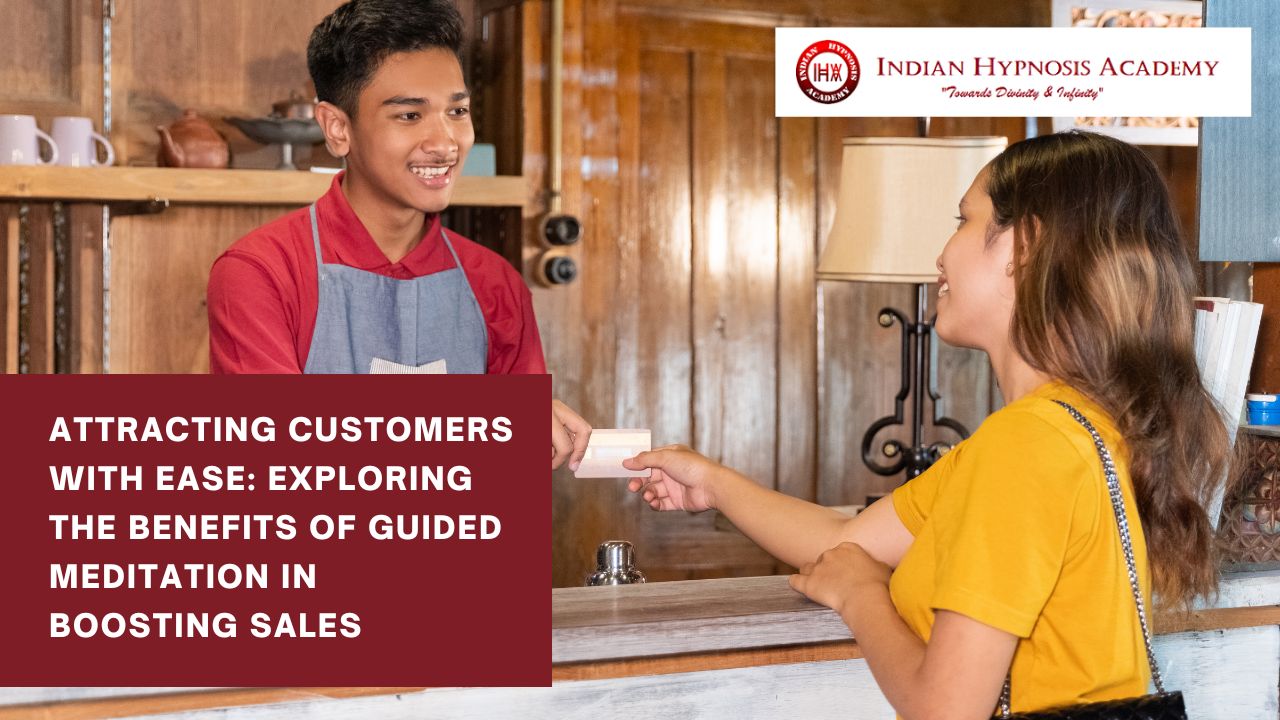Introduction to guided meditation and its benefits
Welcome to a world of mindfulness and business success! In today’s fast-paced and highly competitive market, finding innovative ways to attract customers is crucial for any business. And one method that has been gaining popularity is guided meditation. Yes, you heard it right – meditation isn’t just for personal well-being anymore; it can also be a powerful tool in boosting sales and enhancing the customer experience.
In this blog post, we will delve into the fascinating realm of guided meditation and explore its benefits in attracting more customers. We’ll uncover the connection between mindfulness and consumer behavior, discover how businesses are using guided meditation to their advantage, and provide you with practical tips on implementing this strategy into your own business model.
So grab a comfortable seat, take a deep breath, and let’s embark on this journey together as we unlock the secrets of harnessing the power of guided meditation to attract more customers!
The connection between mindfulness and consumer behavior
Mindfulness, the practice of being fully present in the moment, has gained significant attention in recent years for its numerous benefits to mental health and well-being. However, its impact extends beyond personal development and can also influence consumer behavior.
When individuals engage in mindfulness practices such as guided meditation, they cultivate a heightened sense of awareness. This increased awareness spills over into their purchasing decisions, leading to more thoughtful choices. Rather than making impulsive or unconscious purchases, mindful consumers take the time to evaluate their needs and desires before making a purchase.
Furthermore, practicing mindfulness helps individuals develop empathy and compassion towards others. This translates into a deeper understanding of customer needs and preferences. By recognizing these underlying motivations, businesses can tailor their products or services to better meet customer expectations.
In addition to influencing individual consumer behavior, mindfulness also plays a role in shaping collective consumer trends. As more people embrace mindfulness practices like guided meditation, there is an increasing demand for products that align with values such as sustainability and social responsibility.
Incorporating mindfulness techniques such as guided meditation into business strategies allows companies to tap into the growing market of mindful consumers who prioritize conscious decision-making. By understanding the connection between mindfulness and consumer behavior, businesses can create experiences that resonate with customers on a deeper level while ultimately boosting sales.
How guided meditation can enhance sales and customer experience
In today’s fast-paced and competitive business world, finding innovative ways to enhance sales and provide a memorable customer experience is crucial. One strategy that has gained popularity in recent years is guided meditation. This ancient practice, rooted in mindfulness and self-awareness, can have a profound impact on both customers and employees.
Guided meditation helps create a calm and focused mindset, allowing individuals to fully engage with their surroundings. When customers are in this state of mind, they are more receptive to the messages conveyed by businesses. They become open to new ideas and suggestions, making it easier for companies to showcase their products or services effectively.
Moreover, guided meditation can also improve the overall customer experience. By incorporating mindfulness practices into various touchpoints throughout the customer journey – from initial contact through post-purchase interactions – businesses can foster deeper connections with their clients.
For example, imagine walking into a retail store where soft music plays in the background while soothing voices guide you through relaxation exercises. This serene environment immediately puts customers at ease, making them feel valued and cared for.
Online businesses can also leverage guided meditation techniques through virtual experiences or dedicated mobile apps. By offering pre-recorded meditations tailored to specific needs or preferences (e.g., stress relief or boosting creativity), companies can create personalized moments of tranquility for their customers – even outside traditional brick-and-mortar settings.
The benefits extend beyond just attracting new customers; guided meditation also positively impacts employee performance. When staff members engage in regular mindfulness practices themselves, they become more present during interactions with customers. This presence enhances communication skills and empathy levels – two essential qualities for providing exceptional service.
By implementing guided meditation programs within an organization’s culture as part of employee training or wellness initiatives, companies empower their teams with tools for managing stress effectively while fostering positive relationships with both colleagues and clients alike.
Overall,guided meditation offers significant potential benefits when it comes to enhancing sales growth and improving the customer experience.
Mindfulness practices can put customers at ease, foster deeper connections, and empower employees to provide exceptional service. By incorporating guided meditation into a business strategy, companies can create a more peaceful and positive environment that supports growth and success.
Real-life examples of companies using guided meditation to attract customers
1. Apple: The tech giant understands the importance of a calm and focused mind in today’s fast-paced world. They offer mindfulness sessions for their employees, which not only boosts productivity but also creates a positive work environment. This commitment to employee well-being reflects in the exceptional customer service they provide.
2. Lululemon: Known for their trendy yoga apparel, Lululemon goes beyond just selling products. They organize free guided meditation classes at their stores, inviting both experienced practitioners and beginners to join. This not only attracts potential customers but also builds a sense of community around their brand.
3. Headspace: As one of the leading meditation apps, Headspace has integrated mindful practices into its marketing strategy seamlessly. Their advertisements often feature individuals finding inner peace through guided meditations, resonating with audiences looking for relaxation and stress relief.
4. Calming Spaces Spa: This luxury spa chain incorporates guided meditation as part of its signature treatments. By offering moments of tranquility during massages or facials, they create an unforgettable experience that keeps customers coming back for more.
These real-life examples demonstrate how companies across different industries are leveraging the power of guided meditation to attract and retain customers by providing them with much-needed mental rejuvenation amidst today’s chaotic world.
Tips for implementing guided meditation in your business strategy
1. Start with small steps: If you’re new to implementing guided meditation in your business strategy, it’s important to start small. Begin by offering short meditation sessions during team meetings or incorporating mindfulness exercises into employee training programs.
2. Create a designated space: Consider creating a dedicated meditation room or area within your workplace where employees can retreat and engage in guided meditation sessions. This will help foster a sense of calm and relaxation, allowing employees to recharge and refocus.
3. Provide access to resources: Make sure employees have easy access to guided meditation resources, whether through mobile apps, online platforms, or on-site workshops. Encourage them to explore different techniques and find what works best for them.
4. Lead by example: As a leader, it’s crucial that you practice what you preach. Incorporate guided meditation into your daily routine and openly discuss its benefits with your team. By leading by example, you’ll inspire others to embrace mindfulness practices as well.
5. Seek professional guidance: Consider partnering with experienced mindfulness coaches or instructors who can provide tailored programs for your company’s specific needs and goals. They can guide both individual employees and group sessions effectively.
6. Encourage regular practice: Consistency is key when it comes to reaping the benefits of guided meditation.
Discover ways that encourage regular practice – such as establishing optional lunchtime meditations or setting reminders on shared calendars – so that everyone stays committed.
By implementing these tips in your business strategy, you can create an environment that promotes mental clarity, reduces stress levels among employees,and ultimately boosts productivity and customer satisfaction.
Potential challenges and how to overcome them
Implementing guided meditation in your business strategy may come with its fair share of challenges. One common challenge is skepticism or resistance from employees or customers who may view meditation as a new-age practice with no tangible benefits. To overcome this, it’s important to educate and create awareness about the scientific evidence supporting the effectiveness of guided meditation in reducing stress, improving focus, and enhancing overall well-being.
Another challenge could be finding the time and resources to integrate guided meditation into daily operations. Many businesses operate on tight schedules and budgets, making it difficult to allocate dedicated time for meditation sessions. However, even short moments of mindfulness can make a difference. Consider incorporating brief guided meditations during team meetings or providing access to virtual meditation platforms that employees can use at their convenience.
Maintaining consistency can also be a challenge when implementing guided meditation practices. It’s crucial to establish a routine and stick with it despite hectic work schedules or other disruptions. Encourage employees by leading by example and emphasizing the long-term benefits that consistent practice can bring.
Additionally, some individuals might find it challenging to quiet their minds during guided meditations due to various distractions or racing thoughts. Providing guidance on techniques such as focusing on breath or visualizations can help individuals navigate these challenges more effectively.
By addressing these potential challenges head-on through education, flexibility, consistency, and supportive techniques, businesses can successfully incorporate guided meditation into their strategies while reaping its numerous benefits for both employees and customers alike.
Conclusion: The power of mindfulness in business success
In today’s fast-paced and competitive business landscape, finding effective strategies to attract customers and boost sales is crucial. One often overlooked yet powerful tool that can help businesses achieve these goals is guided meditation. By incorporating mindfulness practices into their business strategy, companies can create a unique customer experience that sets them apart from the competition.
Throughout this article, we have explored the numerous benefits of guided meditation in attracting customers with ease. We have seen how mindfulness can positively influence consumer behavior by promoting emotional well-being, reducing stress levels, and enhancing overall satisfaction.
Moreover, we have delved into how guided meditation can enhance sales by fostering deeper connections with customers through increased empathy and understanding. By creating a calm and welcoming environment for both employees and customers alike, businesses can cultivate an atmosphere of trust and loyalty.
Real-life examples have illustrated how companies across various industries successfully incorporate guided meditation into their business model to attract more customers. From retail stores offering quiet spaces for shoppers to relax to online platforms providing guided meditations as part of their user experience journey, it is clear that mindfulness has become a valuable asset in boosting sales.
If you are considering implementing guided meditation in your own business strategy, keep in mind some essential tips:
- Start small: Begin by introducing short mindfulness exercises during team meetings or training sessions before expanding further.
- Customize your approach: Tailor your meditations to align with your brand values and target audience.
- Promote accessibility: Make sure your offerings are easily accessible to all customers through various channels such as mobile apps or websites.
- Measure success: Implement metrics to track the impact of guided meditation on customer engagement and overall sales performance.
It is important to acknowledge that integrating mindfulness practices may present challenges along the way—some employees might be resistant initially or implementation might require additional resources—but through proper communication, education, and support from management teams, these obstacles can be overcome.
The power of mindfulness in business success should not be underestimated. By creating a more mindful and empathetic workplace, companies can attract customers with ease and ultimately foster long-term success. So why not take the first step towards incorporating guided meditation into your business strategy? The results may surprise you.




